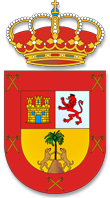Gran Canaria
Miniature ContinentGran Canaria, rarely Grand Canary (archaic), is the third largest island of the Canary Islands, an archipelago located in the Atlantic Ocean 210 km from the northwest coast of Africa and belonging to Spain. It is located southeast of Tenerife and west of Fuerteventura. The island is of volcanic origin, which is mostly made of fissure vents. More info  |
Symbols of Gran CanariaFlagThe flag of Gran Canaria is divided in two by a diagonal line from the lower left corner to the right upper corner. The left upper half is yellow and the right lower half is blue. In the centre the coat of arms of Gran Canaria.
It was created in 1888 as registry flag for the maritime province of Las Palmas.
According to all indications, the choice of forms and colours for all flags of maritime registry was completely arbitrary. Approved: Coat of ArmsThe coat of arms of Gran Canaria is per pale and per fess: first, gules, a castle or, masoned sable, its windows and gate azure; second, silver, a lion gules, crowned, langued and armed gold; and third, a palm-tree on a rock, with a rampant greyhound on each side, facing each other, all proper. Bordure gules, with ten swords silver, placed two by two, crossed in saltire. Ensigned with a royal crown, closed.
It reproduces the arms granted by Queen Juana of Castile in 1506 to the Gran Canaria island council, without the changes made later that identify the current arms of the capital of the island. The two first quarters symbolize Gran Canaria’s ties with the Crown. The third quarter shows the most characteristic plant of Gran Canaria, together with dogs alluding to the alleged etymology of the island’s name, while the swords on the bordure mean the many battles that the Castilians had to fight to achieve its conquest. Approved: Municipalities of Gran Canaria |


